Is there a common alpha-efficiency in polymineral samples measured by various infrared stimulated luminescence protocols?
IF 0.9
4区 地球科学
Q3 Earth and Planetary Sciences
引用次数: 24
Abstract
Abstract Dating of polymineral silt-sized samples by use of post-infrared infrared stimulated luminescence (pIRIR) protocols at elevated temperature has recently gained attraction due to assumed lower rates of anomalous fading. The α-efficiency (or a-value) associated with the pIRIR signals as an integral part of age calculation has, however, not yet been sufficiently constrained. Here we present a set of 65 a-values determined for 47 samples collected across Europe with two different IRSL protocols in two laboratories. By testing the basic preconditions for application of the single-aliquot regeneration (SAR) procedure to constrain a-values and by comparing SAR results to a-values obtained by multiple-aliquot protocols, we demonstrate that SAR-derived a-values are reliable for the majority of samples. While aliquot size and signal resetting mode prior to α-regeneration do not appear to affect the resulting a-value, we detected significant differences in mean a-values measured in the two laboratories. For the pIRIR290 signal, a-values average to 0.085 ± 0.010 (Bayreuth) and 0.101 ± 0.014 (Cologne), while a modified SAR protocol yields 0.081 ± 0.008 (Bayreuth). Whereas provenance-specific differences in a-values might be masked by overall scatter, systematic offsets between laboratories are attributed to technical issues such as heater and source calibration. Based on the present data set, use of the same routine dating equipment is strongly advised for both dose and a-value measurements.是否有一个共同的α效率在多矿物样品测量不同的红外激发发光协议?
摘要:由于假设异常褪色率较低,在高温下使用后红外红外激发发光(pRIR)方案对多矿物粉粒大小的样品进行定年最近受到了关注。然而,作为年龄计算的一个组成部分,与pRIR信号相关的α-效率(或a值)尚未得到充分的约束。在这里,我们展示了一组65个a值,这些值是在两个实验室用两种不同的IRSL方案在欧洲各地采集的47个样本中确定的。通过测试应用单一等分试样再生(SAR)程序来约束a值的基本先决条件,并将SAR结果与通过多个等分试样方案获得的a值进行比较,我们证明SAR导出的a值对大多数样本来说是可靠的。虽然等分试样大小和α-再生前的信号重置模式似乎不会影响产生的a值,但我们检测到两个实验室测量的平均a值存在显著差异。对于pIRIR290信号,a值平均为0.085±0.010(拜罗伊特)和0.101±0.014(科隆),而改良的SAR方案产生0.081±0.008(拜罗伊德)。尽管a值的来源特异性差异可能被总体散射所掩盖,但实验室之间的系统偏移归因于加热器和源校准等技术问题。根据目前的数据集,强烈建议使用相同的常规测年设备进行剂量和a值测量。
本文章由计算机程序翻译,如有差异,请以英文原文为准。
求助全文
约1分钟内获得全文
求助全文
来源期刊

Geochronometria
地学-地球科学综合
CiteScore
2.20
自引率
0.00%
发文量
1
审稿时长
>12 weeks
期刊介绍:
Geochronometria is aimed at integrating scientists developing different methods of absolute chronology and using them in different fields of earth and other natural sciences and archaeology. The methods in use are e.g. radiocarbon, stable isotopes, isotopes of natural decay series, optically stimulated luminescence, thermoluminescence, EPR/ESR, dendrochronology, varve chronology. The journal publishes papers that are devoted to developing the dating methods as well as studies concentrating on their applications in geology, palaeoclimatology, palaeobiology, palaeohydrology, geocgraphy and archaeology etc.
 求助内容:
求助内容: 应助结果提醒方式:
应助结果提醒方式:


